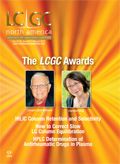Peaks of Interest
Highlights of SFC 2014, Larry Miller and Larry Taylor
Highlights of SFC 2014
Larry Miller , Amgen, Cambridge, Massachusetts, and Larry Taylor, Department of Chemistry, Virginia Tech, Blacksburg, Virginia
The 8th International Symposium on Packed Column SFC (SFC 2014), organized annually by the Green Chemistry Group, was held in Basel, Switzerland, October 8–10, 2014.
Analytical SFC
A key topic of discussion at the symposium was analytical supercritical fluid chromatography (SFC). Although purification is still a major application for SFC, the use of analytical SFC is rapidly increasing. This expansion has been helped by the introduction of advanced SFC equipment that allows the use of smaller particle size stationary phases and offers lower limits of detection and sensitivity equivalent to those seen in high performance liquid chromatography (HPLC). In the past, analytical SFC has been performed only by skilled chromatographers. John Langley from the University of Southampton (Southampton, UK) discussed the use of analytical SFC in a walk-up environment. "Walk-up" users are typically scientists who do not have extensive chromatographic training (organic chemists, students). He described the process, which has been used for open access support, and discussed how SFC is used. He also presented a number of analytical problems that were solved using SFC. The samples included sugars, biofuels, lipids, nucleosides and nucleotides, porphyrins, and molecular wires.
Davy Guillarme from the University of Geneva (Geneva, Switzerland) discussed the possibility of modern SFC coupled to mass spectrometry (MS) for life science applications such as drug metabolism, doping control analysis, and cannabinoid determination. For drug metabolism assays it was shown that SFC is complementary to HPLC, although sensitivity was lower in SFC–MS compared to LC–MS. In doping analysis, acceptable peak shape was observed for urine samples using SFC after dilution with 75:25 acetonitrile–water. The sensitivity of SFC–MS-MS was comparable to LC–MS-MS. For cannabinoid analysis, SFC–MS-MS was significantly more sensitive than LC–MS-MS.
Caroline West from University of Orléans (Orléans, France) presented strategies for choosing an achiral SFC column. Her first recommendation was to choose a stationary phase that matches the polarity of the molecule to be analyzed. Using linear solvation energy relationships (LSER), she classified columns currently available for achiral SFC. Her final recommendation was to choose a stationary phase that reflects differences between the compounds to be resolved in the mixture. For example, if the molecules to be separated differ based on polarity, the use of a polar phase is recommended. Hydrocarbon differences are best resolved on a nonpolar phase, and heterogeneous differences are best resolved with aromatic or mixed alkyl/polar phases.
Other topics included preparative SFC, SFC theory, and new uses for SFC. For more about what was discussed last year at SFC 2014, go to www.chromatographyonline.com/highlights-sfc-2014

New TRC Facility Accelerates Innovation and Delivery
April 25th 2025We’ve expanded our capabilities with a state-of-the-art, 200,000 sq ft TRC facility in Toronto, completed in 2024 and staffed by over 100 PhD- and MSc-level scientists. This investment enables the development of more innovative compounds, a broader catalogue and custom offering, and streamlined operations for faster delivery. • Our extensive range of over 100,000 high-quality research chemicals—including APIs, metabolites, and impurities in both native and stable isotope-labelled forms—provides essential tools for uncovering molecular disease mechanisms and exploring new opportunities for therapeutic intervention.
New Guide: Characterising Impurity Standards – What Defines “Good Enough?”
April 25th 2025Impurity reference standards (IRSs) are essential for accurately identifying and quantifying impurities in pharmaceutical development and manufacturing. Yet, with limited regulatory guidance on how much characterisation is truly required for different applications, selecting the right standard can be challenging. To help, LGC has developed a new interactive multimedia guide, packed with expert insights to support your decision-making and give you greater confidence when choosing the right IRS for your specific needs.

.png&w=3840&q=75)

.png&w=3840&q=75)



.png&w=3840&q=75)



.png&w=3840&q=75)









